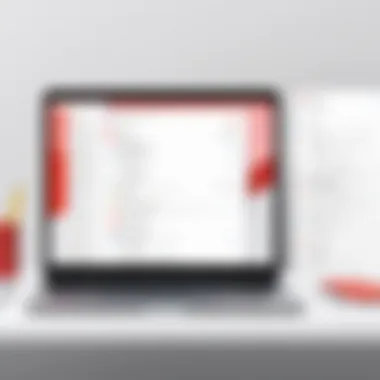A Comprehensive Review of Gmail's Features and Benefits


Intro
In today’s digital landscape, the demand for efficient and reliable email platforms continues to rise. Gmail, developed by Google, has emerged as a dominant player in this space. It offers a range of functionalities designed to enhance communication and collaboration.
This article will explore various aspects of Gmail, including its key features and functionalities, system requirements, and integration capabilities with other tools. It serves as a comprehensive guide for professionals and businesses looking to optimize their email solutions.
In the following sections, we will discuss Gmail's innovative characteristics and its advantages over competing email services. By examining both the strengths and weaknesses of the platform, this article aims to provide readers with insights that will facilitate informed decision-making.
Brief Description
Overview of the Software
Gmail is a web-based email service that allows users to send and receive messages, as well as manage their communication effectively. Launched in 2004, it has since grown into one of the most widely used email platforms globally, boasting over 1.5 billion users. The software is accessible via both desktop and mobile devices, enhancing its usability in diverse environments.
Key Features and Functionalities
Gmail is packed with features that cater to a wide variety of users:
- User-Friendly Interface: The layout is clean, making it easy to navigate.
- Search Functionality: Google’s search capabilities enable users to find emails quickly, even among large volumes of messages.
- Integration with Google Workspace: Seamless integration with tools like Google Drive, Calendar, and Meet allows for enhanced productivity.
- Advanced Security Features: Gmail offers robust security measures including two-factor authentication and malware detection.
- Organization Tools: Labels, filters, and categories help users manage their inbox efficiently.
Gmail's combination of advanced functions and user-friendly design makes it an attractive option for both individuals and businesses.
System Requirements
Hardware Requirements
Gmail operates primarily in a web browser, which means it does not have stringent hardware demands. However, users should ensure that their devices meet basic criteria for optimal performance:
- Processor: Minimum dual-core processor
- RAM: At least 2 GB
- Storage: Internet access and available storage for attachments and files
Software Compatibility
Gmail is compatible with various operating systems. Some of the supported platforms include:
- Windows: Latest versions of Chrome, Firefox, Safari, and Edge
- macOS: Latest versions of Safari, Chrome, and Firefox
- Linux: Chrome and Firefox
- Mobile devices: Gmail app available for Android and iOS
With its flexibility across platforms and devices, Gmail accommodates a diverse user base.
Gmail has effectively integrated features that support collaboration in real-time, making it a preferred choice among professionals.
In the upcoming sections, we will further delve into Gmail’s integration capabilities and security protocols, comparing them to alternative email services.
Prelims to Gmail
The Introduction to Gmail is a fundamental aspect of understanding the overall significance of this email platform. Gmail, developed by Google, has grown to become one of the most utilized email solutions in the world. This section provides insights into its capabilities and benefits for both individual users and organizations. With the rise of digital communication, knowing how to navigate and maximize such a platform is crucial.
Overview of Gmail as an Email Solution
Gmail serves as a comprehensive email solution that caters to a wide range of users. It provides essential features such as robust storage capacities, exceptional email organization tools, and integration capabilities with several applications. Users can easily manage their communications through a user-friendly interface that prioritizes efficiency. Gmail’s customization options allow users to tailor the platform to their needs, enhancing the overall experience.
Moreover, Gmail’s search functionalities stand out, allowing users to find emails quickly through a simple query. Its capacity for organization includes labeling, archiving, and filtering emails. This makes it suitable for both personal use and professional settings, where communication management is essential.
Historical Context and Development
Gmail was introduced on April 1, 2004, during a time when digital communication was rapidly evolving. At its inception, it offered an unprecedented 1 GB of storage, surpassing competitors like Yahoo Mail and Hotmail. This move transformed user expectations for email services and compelled rival platforms to increase their capacities.
Over the years, Gmail has introduced numerous features, including threaded conversations, spam filtering, and a powerful search function. As technology advanced, so did Gmail, integrating with Google Drive, Google Docs, and other tools, which streamlined workflows and enhanced collaboration.
User Interface and Experience
The user interface and experience provided by Gmail play a critical role in the overall effectiveness of this email platform. To stay competitive amid numerous email solutions, a well-designed interface is necessary. A user-friendly UI ensures that users can navigate their inboxes, access features, and customize their settings efficiently. The layout influences how quickly users can perform tasks such as sending emails or organizing inboxes. A good balance between aesthetics and functionality often keeps users engaged.
Navigation and Design
Gmail's navigation and design are essential to its appeal. The layout features a prominent inbox along with categories for updates, promotions, and social features. This clear organization helps users to locate important emails effortlessly. Users can move through different sections with ease, thanks to a consistent navigation pane located on the left-side.


The visual design embraces simplicity, with ample white space and intuitive icons. This focus on minimalism reduces distractions, allowing users to focus on their messages. Additionally, the message preview option is a noteworthy feature. It lets users glance at email contents without having to open each one.
Moreover, the mobile application maintains similar design principles. This coherence across platforms ensures a seamless transition between devices, making email management effective whether on a desktop or a smartphone.
Customization Options
Customization in Gmail allows users to tailor their experience according to personal preferences and workflow requirements. Users may choose different themes to enhance the visual appeal of their interface. Dark mode is a popular choice, providing relief during long periods of email reading and writing.
Furthermore, the layout offers options like density settings. Users can switch between comfortable and compact view options. This flexibility can contribute to an organized and efficient workspace.
Gmail also supports labels. Labels provide another layer of organization by allowing users to categorize emails according to various tags. This encourages a systematic approach to email management, aiding in workflow efficiency.
Accessibility Features
Accessibility features in Gmail are designed to ensure that all users can navigate the platform regardless of their ability. One such feature is the screen reader compatibility. By utilizing standard web accessibility practices, Gmail ensures that visually impaired users can use the platform without difficulty.
Keyboard shortcuts also play a vital role in enhancing accessibility. Users can perform numerous actions without needing to rely on a mouse, improving overall efficiency. These shortcuts are customizable, allowing users to adapt them according to their preferences.
Gmail provides options for captioning voice messages which makes it easier for users who are hard of hearing. In addition to this, adjustable font sizes contribute to better readability for individuals with visual impairments.
By prioritizing user experience and interface accessibility, Gmail aims to provide equal opportunities for all users, reflecting a commitment to inclusivity in digital communication.
Key Features of Gmail
Gmail stands out in the crowded email platform landscape largely due to its variety of features that enhance both individual and organizational communication. Understanding these key features can empower users to maximize their productivity while navigating through their email. Furthermore, the relevance of these features is not limited to their functionality; they reflect Gmail's adaptability to modern communication needs.
Email Organization Tools
The organization tools available in Gmail are integral for maintaining efficiency. Labels, rather than traditional folders, allow users to categorize emails dynamically. This offers flexibility, enabling emails to hold multiple labels. For instance, a client email might be tagged as "urgent" as well as "projects." Additionally, the Priority Inbox feature automatically sorts emails based on importance, optimizing workflow by promoting critical messages to the forefront.
Moreover, the use of filters allows for automated email management. Users can set rules that automatically archive, label, or forward messages, significantly reducing the time spent managing their inboxes. Understanding and utilizing these tools is essential for effective email management in both personal and professional contexts.
Search Capabilities
Gmail's search capabilities are one of its standout features, delivering speed and precision. The sophisticated search functionality enables users to locate specific emails with a few keystrokes, using keywords, sender, date ranges, and even attachment types. This becomes particularly crucial as the volume of received emails increases over time.
Users can use search operators to narrow results. For example, typing "from:example@gmail.com" provides emails specifically from that sender, while "has:attachment" filters emails containing files. Such features not only save time but also prevent the frustration commonly associated with locating important messages in cluttered inboxes. The ability to quickly retrieve information fosters efficiency and enhances communication flow not only for individuals but also for larger teams.
Integration with Google Workspace
Integration with Google Workspace is another compelling feature of Gmail. This seamless functionality allows users to harness tools such as Google Drive, Google Calendar, and Google Docs directly from their email interface. For small businesses and large corporations alike, this integration promotes streamlined workflow, enabling users to schedule meetings, share files, and collaborate on documents without leaving Gmail.
Additionally, with Google Meet integration, video conferencing can occur at the click of a button. This adaptability is especially beneficial in today's remote work environment. Organizations that leverage these integrations can enhance efficiency, ensuring that team members remain connected and productive, regardless of their physical location.
"Effective email management can improve productivity and collaboration results."
Understanding and utilizing these features is not just a matter of preference; for many professionals, it is necessary for maintaining a competitive edge.
Gmail Security Protocols
In today's digital landscape, the security of email platforms cannot be understated. Gmail has established itself as a leader, thanks to its robust security protocols. This section focuses on the mechanisms Gmail employs to protect users from threats, ensuring safe communication for individuals and organizations alike.
Spam Filtering Mechanisms
Spam emails are a persistent challenge faced by many users. Gmail employs advanced spam filtering mechanisms that utilize machine learning. These algorithms analyze patterns and behaviors of incoming emails. Over time, they learn to distinguish between legitimate messages and spam. Users can see these filtered messages in the Spam folder, allowing them to review and recover any accidentally marked important emails.
- Key Features of the Spam Filter:
- Continuously updated to adapt to new spamming techniques.
- Options for users to report spam, improving the filter's intelligence.
- Automatic filtering based on user behavior and preferences.
The effectiveness of this filtering is crucial for businesses and professionals who rely on email communication. It ultimately helps maintain productivity by reducing unnecessary distractions.
Two-Factor Authentication Importance
Two-factor authentication (2FA) adds an essential layer of security to Gmail accounts. By requiring users to provide two forms of verification, it substantially decreases the risk of unauthorized access. In most cases, after entering their password, users must also enter a code sent to their mobile device. This process ensures that even if a password is compromised, the account remains protected.


- Benefits of Two-Factor Authentication:
- Significantly enhances account security.
- Provides peace of mind for users handling sensitive information.
- Easy to enable through Gmail settings, offering increased control over account security.
Enabling this feature is particularly recommended for professionals and businesses managing confidential data or sensitive communications.
Data Encryption Practices
Data encryption is a fundamental practice that Gmail utilizes to ensure security during data transmission and storage. Emails sent through Gmail are automatically encrypted with Transport Layer Security (TLS) when possible, making it difficult for unauthorized parties to intercept or read messages. Moreover, Google implements encryption for stored emails, which protects user data from unauthorized access even in the event of a data breach.
- Key Aspects of Gmail Encryption:
- End-to-end encryption in certain instances, with tools like Gmail S/MIME for business accounts.
- Regular audits and updates to the security infrastructure to stay ahead of threats.
Emphasizing these encryption practices communicates Gmail's commitment to safeguarding user data, reinforcing trust among its users.
"Email security must not be treated as an afterthought; it is a core component of effective communication strategies for organizations."
Understanding these protocols is not just for tech enthusiasts. It is critical for every user who wants to protect their information and maintain their privacy in an increasingly connected world.
Gmail in Business Environments
The significance of Gmail in business environments is profound. As organizations evolve, the tools they use for communication must also adapt. Gmail offers a reliable platform that caters to the diverse needs of modern businesses. Its features go beyond simple email functionalities, becoming integral to workflows and collaborative efforts.
In the contemporary corporate landscape, efficiency and seamless communication are paramount. Gmail enables quick sharing of information and enhances collaboration among team members. This platform not only serves as a communication tool but also integrates with various services that support productivity goals.
Collaborative Features for Teams
One of the standout aspects of Gmail is its collaborative features. It facilitates teamwork through shared email functionalities, promoting transparency and cooperation. Team members can easily create and manage shared inboxes, helping them monitor inquiries and respond efficiently. This ensures that no critical messages get lost amidst the digital avalanche.
Gmail's integration with Google Meet and Google Chat further enhances collaboration. Teams can hold virtual meetings directly from their email interface, simplifying scheduling and eliminating the need for third-party applications. Additionally, Google Drive allows for easy file sharing, making documents and files accessible right from Gmail. This promotes a unified approach to collaboration, keeping everything organized and accessible.
"Gmail redefines how teams interact, merging communication with productivity effortlessly."
Task management tools like Google Tasks allow users to keep track of assignments alongside their emails. This helps maintain focus on priorities while staying organized. The ability to assign tasks or set reminders within email threads encourages accountability and keeps projects on track.
Integration with Business Applications
The integration capabilities of Gmail with other business applications is a significant market advantage. Services such as CRM tools, project management software, and other essential business applications can be synchronized with Gmail. This allows users to manage multiple accounts without leaving the email interface.
For instance, software like Salesforce or HubSpot connects seamlessly with Gmail. This means sales teams can manage customer interactions directly from their inbox. Tracking communication with clients becomes simpler and more efficient, fostering better relationships through timely follow-ups.
Moreover, various calendar applications can sync directly with Gmail. Meeting invitations can be sent and accepted without switching tabs, streamlining the scheduling process across teams. Mail merge features can also be utilized for outreach campaigns, allowing users to send personalized emails to multiple recipients effortlessly.
Comparative Analysis with Other Email Platforms
The comparative analysis of Gmail with other email platforms is crucial for understanding the unique functionalities and characteristics of each service. This section aims to provide insights into how Gmail stands against competitors like Microsoft Outlook, Yahoo Mail, and ProtonMail. The analysis not only reveals the strengths and weaknesses of Gmail but also allows users to determine which service best meets their needs based on specific criteria such as user interface, collaboration capabilities, and privacy controls.
Gmail vs Outlook
Gmail and Microsoft Outlook both offer robust features suited for professional use. Gmail is part of the Google Workspace ecosystem, which allows seamless integration with applications such as Google Drive and Calendar. This enables effortless collaboration among users, particularly in business environments.
Outlook, on the other hand, is tailored for desktop use. Its integration with Microsoft Office applications makes it a preferred choice for users already invested in Microsoft's software ecosystem.
- User Interface: Gmail has a more minimalist and straightforward design compared to Outlook's more complex layout. Users familiar with Gmail may find Outlook's plethora of features a bit overwhelming.
- Business Tools: Both platforms provide tools for scheduling and teamwork, but the approach varies. Gmail emphasizes cloud-based solutions, while Outlook provides strong offline capabilities with its desktop version.
- Customization: Gmail offers extensive customization through labels and filters, allowing users to manage their inbox more efficiently.
Ultimately, the choice between Gmail and Outlook often comes down to user preference and existing software integration.
Gmail vs Yahoo Mail
When comparing Gmail to Yahoo Mail, several factors come into play. While Yahoo Mail is one of the oldest email platforms available, it has pursued continuous development to retain user interest. However, Gmail generally maintains a technological edge.
- Storage: Gmail offers 15 GB of free storage shared with other Google services, while Yahoo Mail provides 1 TB of storage. Although Yahoo Mail offers significantly more space, Gmail's integration with other tools often compensates for this.
- User Experience: Gmail’s user-friendly interface is often preferred by users who value speed and simplicity. Yahoo’s added features can complicate navigation for some users.
- Security Features: Both platforms have advanced security measures, but Gmail's two-factor authentication and robust spam filtering are widely recognized as superior.
While Yahoo Mail has its unique strengths, Gmail's additional integration capabilities with Google services often make it a more appealing option for users.


Gmail vs ProtonMail
ProtonMail represents a different sector of email services, focusing primarily on security and privacy. In contrast, Gmail, while having robust security features, operates on a more traditional model, which includes ad-based income generation.
- Privacy: ProtonMail offers end-to-end encryption, ensuring that only the user can access their emails. This is a significant advantage for users prioritizing confidentiality. Gmail, however, remains a strong option with its extensive features, even if it does not prioritize privacy in the same manner.
- User Accessibility: Gmail's interface is designed for ease of use and provides quick access to features, which many users prefer. ProtonMail's interface might feel limited for those used to the comprehensive feature set of Gmail.
- Cost: ProtonMail operates on a freemium model, with advanced features requiring payment. Gmail provides a solid free option while integrating with the broader suite of Google Workspace tools for businesses who require additional functionality.
Challenges and Limitations of Gmail
Understanding the challenges and limitations of Gmail is critical for users, whether they are individuals or businesses. Despite being a robust email platform, Gmail has specific areas where users may encounter issues. An examination of these factors can aid in understanding the overall effectiveness of Gmail as an email solution. In this section, we will delve into two significant aspects: storage capacity issues and privacy concerns.
Storage Capacity Issues
Gmail offers users a substantial amount of free storage; currently, it provides 15GB shared across Google services, including Google Drive and Google Photos. However, as users accumulate data over time, they may find this space insufficient.
When the storage limit is reached, users cannot send or receive new emails. This situation can lead to disruptions in communication, which is particularly detrimental for businesses that rely heavily on email for daily operations. Users must regularly manage their storage by deleting unimportant emails or upgrading to a paid plan to gain additional space.
Moreover, the system tends to retain emails and other data indefinitely unless actively deleted. This automatic storage increase can lead to a cluttered account, making it challenging to find essential emails due to disorganized storage. Users should employ efficient management strategies, such as archiving tweets and utilizing labels or categories to keep their accounts streamlined.
"Storage management is a crucial consideration for any effective email workflow."
Privacy Concerns
Privacy is a significant concern for many Gmail users. The platform has faced scrutiny regarding its data collection practices. Google's data policies have been a point of contention, particularly as they pertain to user information being utilized for advertising purposes. While users often accept terms without thorough reading, the implications of these policies may not be entirely clear to everyone.
For businesses handling sensitive information, a lack of clarity around data privacy can raise red flags. Organizations must evaluate whether using Gmail aligns with their confidentiality requirements. Furthermore, security vulnerabilities can present risks, despite Gmail's robust security measures like two-factor authentication.
While Gmail provides some privacy features, many users may feel they have limited options for maximizing their email privacy. The platform's integration with other Google services can make users feel their information is less secure than on platforms specifically designed with privacy in mind, such as ProtonMail.
Gmail's Evolving Role in Communication
Gmail has not only transformed how individuals communicate but has also played a pivotal role in shaping broader communication trends. As a widely used email platform, its functionality extends beyond letter writing. It is crucial to recognize how Gmail adapts to the changing digital landscape. Understanding this evolution helps users appreciate its capabilities in facilitating both personal and professional correspondence.
Impact of Email on Modern Communication
Email remains a cornerstone of modern communication. With the rise of instant messaging and social media, email's role has evolved but not diminished. Gmail, as a dominant email service, exemplifies this trend. Its interface promotes quick interaction while accommodating detailed exchanges when necessary.
Moreover, the integration with other Google services enhances user experience, allowing seamless transitions from emailing to collaboration on documents via Google Docs or scheduling meetings through Google Calendar. This interconnectedness provides a strategic advantage for both individuals and organizations, fostering improved productivity.
Furthermore, the ability to organize emails into categories and labels streamlines communication. Users can prioritize tasks efficiently, addressing essential messages first and ensuring that nothing falls through the cracks. The intelligent sorting of emails reflects a broader trend of managing digital communication effectively.
Trends in Email Usage
As businesses and individuals navigate their communication preferences, trends indicate a few significant shifts in email usage. One major trend is the increasing importance of mobile access. With apps provided by Gmail, users can read and respond to emails instantly, enhancing responsiveness and flexibility.
Another notable trend is the incorporation of advanced security features. Given the rising concerns regarding data privacy, platforms including Gmail are continually updating their security measures. For instance, features like encrypted emails and phishing detection contribute to safer communication.
Additionally, the frequency of email use is changing, with many users opting for concise messages. People are more inclined to use email for essential communications while relying on instant messaging for casual interactions. This trend highlights the need for effective writing skills in email communication, as users must be able to convey messages clearly and succinctly.
"Gmail's evolution is closely aligned with shifting communication demands, reflecting how users interact in a fast-paced digital environment."
Overall, Gmail’s evolving role in communication offers insights into how technology adapts to user needs. By examining its impact and the trends shaping email usage, we can understand why it remains a vital tool in both personal and professional contexts. The ongoing advancements in Gmail signal its commitment to optimizing user communication and enhancing overall productivity.
Culmination and Future Outlook for Gmail
The conclusion of this exploration into Gmail's functionality serves not only as a summary but also a projection into what the future holds for this email platform. Gmail has firmly established itself as a key player in the email ecosystem, catering to a diverse range of users. Its adaptability and integration capabilities have led it to become the email solution of choice for many.
In reviewing Gmail's current features, it is evident that its success hinges on strategic innovations. The article highlights the importance of Gmail's unique selling points—such as its superior search functionalities and organizational tools. These features not only enhance user experience but also streamline communication processes, making them invaluable for both individual users and organizations.
Summary of Key Insights
- Integration and Collaboration: Gmail's seamless integration with other Google Workspace products facilitates a culture of collaboration. Tools like Google Drive and Google Meet enhance team productivity, making it a vital asset for businesses.
- User Interface and Customization: The user interface allows for significant customization. This feature enables users to tailor their experience to match their workflow needs. Thus, productivity and satisfaction can be optimized through personalized settings.
- Security Features: The emphasis on security with two-factor authentication and spam filtering builds trust among users. In an age where privacy is paramount, Gmail's protocols uphold data integrity effectively.
- Accessibility: Features designed specifically for accessibility demonstrate Gmail's commitment to inclusive design. This ensures all users, regardless of ability, can effectively use the platform.
In summary, Gmail provides not just an email service but a fully integrated communication solution that meets evolving user needs.
Anticipated Enhancements
Looking forward, several enhancements can be anticipated. Gmail’s ongoing evolution indicates a willingness to adapt and integrate user feedback. Here are some likely developments:
- Advanced AI Integration: The use of artificial intelligence can enhance email sorting and automated responses. AI could also provide smart suggestions for scheduling and task management within the platform.
- Improved Data Analytics: For business users, tools offering insight into email engagement and response rates may become more prevalent. Analytics can influence communication strategies and improve project outcomes.
- Enhanced Customization Options: Future updates might include even more sophisticated customization features, allowing users to manipulate workflow processes extensively.
"Understanding how Gmail's features evolve will ensure users maximize its potential for their personal and professional needs."
As the landscape of communication continues to change, Google appears committed to enhancing Gmail's functionalities to remain competitive. Monitoring these changes and adapting accordingly will be essential for current and prospective users.



